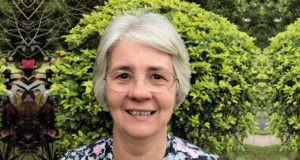It’s one of our eternal questions with no easy answers: what happens to us after we die? Although the statistics suggest many Australians believe in the afterlife, what exact form that takes is still up for debate, whether you’re a Christian or not. Rev Dr David Mackay-Rankin explores the afterlife, the Christian theology underpinning it and its depiction in popular culture.
The subject of the afterlife—of an existence beyond this one—comes with a number of questions. Is it real? How many stages of the afterlife are there? Is there an unbroken continuity of time, space and personal identity between this world and the next? Will I still be the same me there? Is there contact between this world and the next? Whom will I meet there?
We cannot, of course, deal with all of these questions here.
It would be fair comment to say that whatever varieties of belief might exist within our church concerning the existence and the nature of an afterlife, the Uniting Church does not itself hold a clearly defined position doctrinally on all possible aspects of this matter. This is apart from its embrace of the scriptural and credal notion of the resurrection of the dead (however understood) and brief references in both The Basis of Union and the liturgy for The Funeral Service (Uniting in Worship 2) to the afterlife and this is probably appropriate.
The Basis
In Paragraph 3 of the Basis it is said that, “The Church lives between the time of Christ’s death and resurrection and the final consummation of all things which Christ will bring; the Church is a pilgrim people, always on the way towards a promised goal; here the Church does not have a continuing city but seeks one to come.”
This is as close as the Basis comes to commenting on the afterlife and it is a wording short on detail. In the liturgy for funerals while there is no sustained commentary on the afterlife, various references suggest what might amount to some clear understandings of aspects on this. In the introduction, for example, it says that “while death is the end of mortal life, it marks a new beginning in our relationship with God”, suggesting a continued personal existence, in some largely undefined form, beyond death.
In one of the prayers offered in praise of Christ it reads, “[f]or this assurance of our new life in Christ, and for the great company of the faithful whom you have received into your eternal joy, all praise and thanks be given to you, O God, forever and ever.” And then later prayer is offered that God might “comfort us now with the assurance of the life that is beyond this life, and of a reunion [my emphasis] with those we have loved long since and who wait for us in your heavenly presence”.
In the Prayer of Committal, as elsewhere in the liturgy, we hear of the “sure and certain hope of the resurrection to eternal life”. Among the concluding prayers is one that God “might continue to lead us until our hope is fulfilled and we join all God’s people in never-ending praise” and another that God might “enable us to go forward in faith to meet [Christ] that, when our life on earth has ended, we may be reunited [my emphasis] with all who love him in your heavenly kingdom” (somewhat different from the “reunion” with loved ones spoken about earlier?). All these prayers speak to an existence beyond this present one, however undefined as to actual detail, one in the company of Christ, of loved ones and of the faithful.
The Bible
The Bible itself, of course, speaks at many points of a life beyond this one but there is much argument among scholars about how such passages might actually be read or interpreted. Apart from Paul’s classic pieces at 1 Corinthians 15 and 2 Corinthians 4 and 5 on the resurrection both of Christ and of the faithful, other passages pointing to an existence beyond this one include Luke 23:42 (the thief beside Jesus on the cross and the promise of ‘paradise’), John 14:2 (the way-stations—the “mansions”—on the path post-death), Philippians 1:23b (Paul’s clear preference to “depart [die] and be with Christ”), and Luke 16:19-31 (the Rich Man and Lazarus post-death in Hades and with the angels and Abraham respectively).
One argument among biblical scholars is about whether the transition from death to resurrection is immediate (there being no time as we might know it in the afterlife given that time is itself, as Augustine suggests, part of the created order) or whether there is an intermediate space first, one between death and the time of the resurrection.
This discussion was also picked up by early second and third century Christian theologians one of whom, Origen of Alexandria, suggested that an intermediate space between death and resurrection would provide time for the faithful departed both to come to terms with and understand better their past life and to prepare for the life yet to come.
The wider church
In the history of the Christian Church some traditions have likewise, alongside the general acceptance that there is an existence beyond this one, adopted the notion that there is an intermediate or in-between space between death and resurrection.
Thus within Roman Catholic teaching there has been found, explicitly since the 12th century but implicitly much earlier, the idea of Purgatory. This supposed place, though by no means providing a comfortable or pleasant experience for residents, is not (as often popularly understood) one for the reprobate, but rather for the not-quite-righteous-enough-yet who require just a little more work before advancing to heaven.
The Catechism of the Catholic Church describes Purgatory as the place for the “purification of the elect, which is entirely different from the punishment of the damned”. While this idea of the existence of Purgatory is explicitly repudiated by the Thirty-nine Articles of the Church of England and by most Protestants and Orthodox, 18th century Anglican priest and the primary founder of the Methodist movement, John Wesley, for example, maintained in both private correspondence and various sermons (though the idea was not taken up as official Methodist doctrine) that there existed an intermediate stage between death and resurrection to enable further “growth in holiness [sanctification]”.
Other major religious traditions also maintain the notion of this intermediate or transitional space. Within Judaism, for example, and certainly from the third century CE/AD onwards, there are found schools of thought which accepted the idea of a third group of the dead (of the other two groups, one goes straight to heaven and the other immediately downstairs) who, not quite righteous enough yet for heaven, will undergo a period of refinement before they can also, like the first, move onwards and upwards. And Islam, too, has such an in-between place called the barzakh, as does Buddhism (particularly the Tibetan brand) posit the bardo as a space occupied post-death but before reincarnation.
Understanding the numbers
A 2005 national survey of Australian teens and young adults (13–24 years)—The Spirit of Generation Y (SGY)—found that 56 per cent believed in life after death without necessarily indicating what form such an existence might take.
It is worth noting, however, that a majority of those surveyed in SGY who expressed such a belief in an afterlife also expressed one in reincarnation. Figures drawn from the 2009 Australian Survey of Social Attitudes (AuSSA)—taken from across a broader age range—showed that 46 per cent of those surveyed believed in an afterlife.
Another Australian survey conducted just after the AuSSA, in 2010—the Afterlife in a Secular Age project—with 52 people aged from 18 to 85, with roughly a third in each of the age groups 18–24, 25–49 and 50–85, approximately one half (27) expressed some belief in an afterlife (but not reincarnation), 9 in reincarnation, and 16 (nearly a third) that death is the end.
Thus in this country belief in an afterlife, though not necessarily one of a traditional or conventional kind, is alive (so to speak) and well, and particularly so among younger Australians.
Many scholarly surveys have also been carried out on popular beliefs about the afterlife in the United Kingdom and the United States. The UK surveys have suggested similar figures to those from Australia, if perhaps slightly higher, while those from the US somewhere between 70 per cent (across the age ranges) and 90 per cent (among the college-aged).
What the Australian surveys for their part also demonstrated, however, was that very few of those who believe in an afterlife in this country are influenced in this by traditional religious teachings, and that this includes many people with a declared faith. Afterlife belief in this country, suggested one of the researchers, is “a highly individualised and private matter”.
Although there’s not enough space for a thorough examination of all the details of these survey findings, some of the latter are worth mention here. The UK survey showed that some 15 per cent of those polled believed in a form of reincarnation, US surveys between 30 and 56 per cent, while Australian studies suggest a figure between 17 and 30 per cent.
On the matter of reunions with family members or loved ones in the afterlife the question was not asked specifically in either the UK or Australian surveys—although the work of Ellen Clark-King in exploring religious faith among women on a Newcastle (UK) housing estate (Theology by Heart) has suggested a significant level of belief in the possibility of such reunions and interviews with some Australian survey respondents did elicit some comments suggesting such a belief—while the US ones among college students, where the question was specifically asked, suggest somewhere in the high 80s.
Belief in the possibility of communication or contact of some sort between the dead and the living showed up in from 60 to 70 per cent of responses to the US surveys, while Clark-King’s work brought forth a number of claims of personal contact with the dead.
On screen and on the page
The results of these surveys on beliefs in an afterlife—and a number of popular, contemporary novels, young adult and adult alike, on the same theme—are also backed by its representation in a number of contemporary films, particularly the notion of an intermediate, transitional existence post-death in which unresolved issues left over from life in the present are resolved, films such as Ghost, Truly, Madly, Deeply, What Dreams May Come, The Sixth Sense, The Others, Always, Ghost Town, The Lovely Bones, and Hereafter among them. Correspondences with, if not necessarily influences by, the Buddhist notion of the bardo and the Catholic purgatory—one mainstream film, set in an afterlife Western town in the US (with a town and a saloon), is even titled Purgatory—are clear.
In Gabrielle Zevin’s very popular young adult novel elsewhere (the list of contemporary young adult novels on the theme of life after death seems almost endless, suggestive of a deep interest in the afterlife among young people in the West) the lead character, 15-year-old Lizzie Hall, recently killed in a road accident, when sighting land (the place we come to know as “Elsewhere”) from the ship transporting her and others to their particular afterlife, declares with some relief that, “If you have to be dead, it is better to be somewhere, anywhere, than nowhere at all.”
Beyond the grave
In his First Letter to the Corinthians Paul famously declares, contrasting the present age with the one to come: “For now we see in a mirror, dimly, but then we will see face to face. Now I know only in part; then I will know fully, even as I have been fully known.”
The brief investigation above of confessional documents, liturgies, surveys, films and novels suggest a contemporary widespread, popular belief in an afterlife including more than one post-death stage, the continuity of personal identity between this world and the next, and the possibility of contact between the worlds of the living and the dead.
These sources suggest views of an afterlife where understanding replaces what once seemed uncertain, knowing what previously seemed unknown, resolving what had been hitherto unresolved, and making sense of what formerly
did not.
In the 2004 film The Five People You Meet in Heaven amusement park maintenance worker Eddie, killed by falling machinery while trying to save the life of a young girl, is told by an old friend in the afterlife,
“The way I see it, that’s what we’re getting here. That’s what heaven is. You get to make sense of your yesterdays.”
Rev Dr David Mackay-Rankin is a former Principal of Trinity Theological College. His most recent book, The Early Church and the Afterlife, was published by Routledge (UK) in 2017.
 JourneyOnline
JourneyOnline







